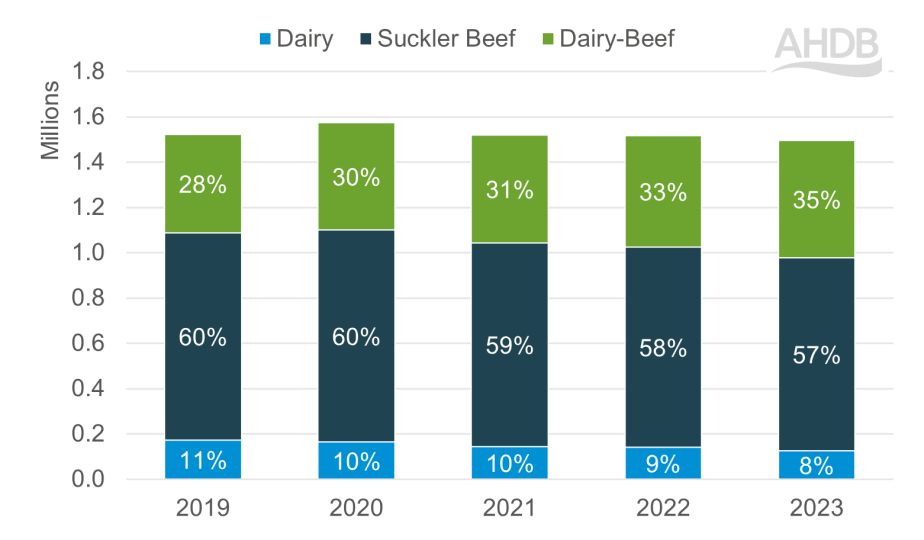How much beef is produced from the GB dairy herd?
Wednesday, 3 April 2024
Dairy-beef (or beef from the dairy herd) is playing an ever-growing part in the UK beef market and supply chain. But how much does the GB dairy herd contribute to British beef production, and how is that changing? We explore the latest data to find out.
Key points
- Just over half of all cattle slaughtered in GB abattoirs are born to the dairy herd
- Registrations of dairy-beef calves have risen by 77% over the past 10 years due to rising use of beef semen by dairy producers
- Dairy-beef made up 35% of GB prime cattle (12–30 months) slaughter in 2023, up from 28% in 2019
- Aberdeen Angus birth registrations to the dairy herd continue to grow; Wagyu registrations showed a notable uplift in 2023
Total production levels
Data from the British Cattle Movement Service (BCMS) tells us that in 2023, 2.28 million cattle (of all ages) were slaughtered in GB.
Approximately 52% of these animals were born to dairy dams, with the remainder born to non-dairy (beef) dams. This includes all animals slaughtered regardless of age and sex, so it encompasses prime cattle (including dairy heifers) and older cull animals.
We can therefore conclude from this data that just over half of cattle slaughtered for beef in GB currently come from the dairy herd.
Prime beef production
Looking at animals slaughtered at “prime” ages (12–30 months old), the proportion born to dairy dams has risen gradually over time, driven by a rise in dairy-beef. However, the majority of slaughtered prime cattle remain suckler-born.
In 2023, approximately 43% of slaughtered prime cattle had dairy dams, up from 40% in 2019.
The proportion of slaughtered cattle that can be classified as “dairy-beef” stood at 35% (that is, animals registered as “beef” with a dairy dam). This has risen steadily over time, up from 28% in 2019.
Simultaneously, the proportion of cattle slaughtered as suckler-beef (beef animal from a beef dam) has fallen slightly, accounting for 57% of total prime slaughter in 2023, down from 60% in 2019.
Meanwhile, the proportion of pure dairy cattle slaughtered has continued to reduce (-18%).
Proportion of cattle slaughtered in GB between 12 and 30 months of age by type
Source: BCMS, AHDB calculations
Mixed trends in popular dairy-beef breeds, while Wagyu numbers tick up notably
Unsurprisingly, the most populous individual breed of calf registered to the dairy herd continues to be Holstein Friesian (X*) (25% of registrations in 2023 ). However, the share of Holstein-Friesian (X*) calves born has continued to fall.
By contrast, registrations of popular beef breeds have continued to rise, particularly Aberdeen Angus (X*) (20% of dairy registrations in 2023 ) and Hereford (X*). British Blue (X*) remains the third most populous dairy-beef cross breed, but after several years of growth, the number of BRBX animals registered plateaued in 2023.
Meanwhile, dairy-born registrations of Wagyu (X*) calves showed significant uplift in 2023, following a few years of steady growth. Over 31,000 Wagyu (X*) calves were registered to the dairy herd in 2023, over double the number registered during the previous year, and overtaking registrations of Jersey (X*) and Simmental (X*).
Trends in birth registrations to the dairy herd by calf breed (top 10) (includes pure and cross-bred)
Source: BCMS, AHDB calculations
*Data includes animals registered as crosses, so for example: “Aberdeen Angus” + “Aberdeen Angus X”.

Sign up for regular updates
You can subscribe to receive Beef and Lamb market news straight to your inbox. Simply fill in your contact details on our online form.
While AHDB seeks to ensure that the information contained on this webpage is accurate at the time of publication, no warranty is given in respect of the information and data provided. You are responsible for how you use the information. To the maximum extent permitted by law, AHDB accepts no liability for loss, damage or injury howsoever caused or suffered (including that caused by negligence) directly or indirectly in relation to the information or data provided in this publication.
All intellectual property rights in the information and data on this webpage belong to or are licensed by AHDB. You are authorised to use such information for your internal business purposes only and you must not provide this information to any other third parties, including further publication of the information, or for commercial gain in any way whatsoever without the prior written permission of AHDB for each third party disclosure, publication or commercial arrangement. For more information, please see our Terms of Use and Privacy Notice or contact the Director of Corporate Affairs at info@ahdb.org.uk © Agriculture and Horticulture Development Board. All rights reserved.



.png)